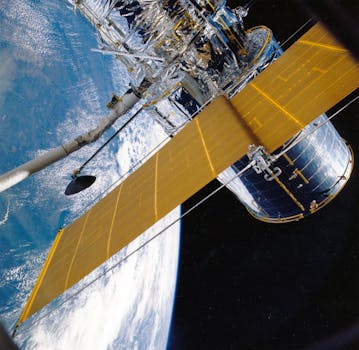From Geostationary to Low Earth Orbit: The Evolution of Satellite Telecommunications in 2023
The satellite telecommunications industry has undergone significant changes in recent years, with a shift from geostationary to low Earth orbit satellites. This article explores the evolution of satellite telecommunications in 2023, including the benefits and challenges of low Earth orbit satellites.

From Geostationary to Low Earth Orbit: The Evolution of Satellite Telecommunications in 2023
Focus Keyword: Satellite Telecommunications
Satellite telecommunications have come a long way since the launch of the first geostationary satellite in 1963. For decades, geostationary satellites have been the backbone of the satellite telecommunications industry, providing a wide range of services including television broadcasting, telecommunications, and navigation. However, in recent years, there has been a significant shift towards low Earth orbit (LEO) satellites, which are revolutionizing the industry with their improved capabilities and reduced costs.
The shift from geostationary to LEO satellites is driven by several factors, including the need for higher bandwidth, lower latency, and greater flexibility. LEO satellites operate at an altitude of around 160 to 2,000 kilometers, which is much lower than the 36,000 kilometers of geostationary satellites. This lower altitude enables LEO satellites to provide faster data transfer rates, lower latency, and more precise location tracking. Additionally, LEO satellites are less expensive to launch and operate than geostationary satellites, making them an attractive option for companies looking to provide satellite-based services.
The Benefits of Low Earth Orbit Satellites
LEO satellites offer several benefits over geostationary satellites, including improved performance, increased capacity, and enhanced security. With their lower altitude, LEO satellites can provide faster data transfer rates, making them ideal for applications that require high-speed data transfer, such as video streaming and online gaming. LEO satellites also offer lower latency, which is critical for real-time applications such as voice and video communications. Furthermore, LEO satellites are more resistant to jamming and interference, making them a more secure option for sensitive communications.
Another significant advantage of LEO satellites is their ability to provide global coverage with a smaller constellation of satellites. While geostationary satellites require a single satellite to cover a large portion of the Earth’s surface, LEO satellites can provide global coverage with a constellation of dozens or even hundreds of satellites. This enables companies to provide satellite-based services to a wider range of customers, including those in remote or underserved areas.
The Challenges of Low Earth Orbit Satellites
While LEO satellites offer several benefits, they also present some challenges. One of the main challenges is the need for a large constellation of satellites to provide global coverage. This requires significant investment in satellite manufacturing, launch, and operation. Additionally, LEO satellites have a shorter lifespan than geostationary satellites, typically ranging from 5 to 10 years, which means that companies must constantly launch new satellites to replace old ones.
Another challenge facing LEO satellites is the issue of space debris. With thousands of satellites in orbit, there is a growing concern about the impact of space debris on the environment and the risk of collisions between satellites. To address this issue, companies are developing new technologies and strategies for responsible satellite operations, including de-orbiting satellites at the end of their lifespan and using advanced propulsion systems to maneuver satellites and avoid collisions.
Conclusion
In conclusion, the evolution of satellite telecommunications in 2023 is marked by a significant shift from geostationary to LEO satellites. LEO satellites offer several benefits, including improved performance, increased capacity, and enhanced security. While they also present some challenges, companies are developing new technologies and strategies to address these issues. As the demand for satellite-based services continues to grow, it is likely that LEO satellites will play an increasingly important role in the satellite telecommunications industry.




